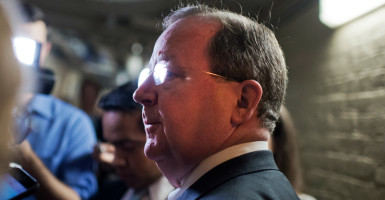As the House Budget Committee approved a $1.07 trillion budget plan on Wednesday night, a leading conservative group was set to propose its own fiscal blueprint that spends less money, in the hope it would inspire the Republican conference to move in the same direction.
The Republican Study Committee’s budget, which will officially be unveiled on Thursday, proposes $974 billion in discretionary spending for fiscal year 2017, compared to the $1.07 trillion figure that House leadership is pushing.
The Republican Study Committee (RSC), which includes more than 170 House members, releases an alternative budget every year in an attempt to make the main House Republican budget more conservative.
According to an executive summary of the proposal obtained by The Daily Signal, the budget would slice $8.6 trillion in spending over a decade — more than $2 trillion more in cuts than the Budget Committee’s blueprint — and balance in eight years without increasing revenues.
The budget also boosts defense spending, proposing $574 billion in base discretionary funding, plus $59 billion in a separate account dedicated to fight terrorism. It fully repeals the Affordable Care Act, eliminates the Export-Import Bank and Internal Revenue Service, imposes work-requirements on obtaining food stamps and earning Medicaid — and turns that program into a block grant — and raises the retirement age for Social Security to 70.
While the Republican Study Committee budget is only aspirational, and almost certainly won’t be adopted by the full House, its release signals that conservatives will challenge House leadership’s preferred outcome of embracing a budget that adheres to higher spending levels established in a deal reached by Democratic and Republican leaders last year.
The blueprint passed by the Budget Committee, which sticks to last year’s budget deal, is short of the GOP votes needed to get it through the full House.
Some have speculated that the challenge to unite the conference may be so great that House Republicans won’t pass a budget at all. Republican Study Committee Chairman Bill Flores doesn’t want to see that happen. But the terms he is calling for make that an open question.
Flores, R-Texas, said his preferred path forward is for the Republicans to go back to the $1.04 trillion discretionary spending level that was set in 2011 under automatic spending cuts known as sequestration.
“I don’t think nothing is a good option,” Flores told reporters at The Heritage Foundation on Wednesday. “I see a path forward at 1040 [$1.04 trillion] and so my goal is to try and convince leadership to move forward at 1040.”
Those who support keeping the $1.07 trillion level argue that adopting a budget that is consistent with last year’s deal between President Barack Obama and former House Speaker John Boehner– a figure that’s already set into law — ensures that Republicans can move forward this year on passing individual spending bills during a normal appropriations process.
In recent years, Democrats in the Senate have stalled the appropriations process, known as “regular order,” because they believe Republican proposals cut too much money, and advance policies they don’t support, which has led to Congress combining everything into a last-minute, all-in-one package known as an omnibus.
Republican leaders insist this year could be different because they say Democratic leader Sen. Harry Reid of Nevada has committed to allow the appropriations process to run normally this year — but only if Republicans pursue spending bills that adhere to the numbers set in last year’s deal.
“We have an agreement with the Senate that they will allow us to proceed on appropriations bills assuming we honor our agreement,” said Rep. Charlie Dent, R-Pa., who leads the more moderate Tuesday Group, in an interview with The Daily Signal.
“If we go to 1040 [the $1.04 trillion spending level] we will be accused of reneging on our agreement and the appropriations process will look exactly like last year and force us into an omnibus at the end of the year.”
The House Freedom Caucus, a smaller conservative group that includes some members who belong to the Republican Study Committee, is also asking for Republicans to reduce spending by $30 billion in order to return to the $1.04 trillion number.
The challenge is that House Speaker Paul Ryan and his leadership team believe Republicans have an obligation to adopt the $1.07 trillion budget that fulfills the spending terms of the deal negotiated before he replaced Boehner.
Budget Committee Chairman Tom Price, R-Ga., released his budget blueprint earlier this week.
Dubbed the “Balanced Budget for America,” the document aims at balancing the budget and reducing the deficit by $7 trillion in a decade.
“I commend Chairman Price for passing a responsible, conservative budget that cuts the deficit by $7 trillion and balances within a decade—all without raising taxes,” Ryan said in a statement Wednesday night.“This blueprint also repeals Obamacare, shrinks the EPA, improves Medicare and Medicaid, strengthens our military, and calls for tax reform. It represents our vision for a smaller government and healthier economy, and it’s a document that can make all conservatives proud.”
Though the Budget Committee advanced its budget blueprint forward, some members signaled they are less committed to maintain that support if a vote were to come before the full House.
Indeed, one member, Rep. Gary Palmer, R-Ala., who belongs to the Freedom Caucus, voted yes on the budget with the higher spending levels in committee, but plans to oppose the measure on the House floor, his spokeswoman told The Daily Signal.
Dent believes the Budget Committee proposal with the $1.07 trillion in spending would draw more support than one that spends less.
But at least 30 members of the 40-member Freedom Caucus have vowed to oppose the Budget Committee proposal, and some in the Republican Study Committee are unlikely to support the measure as well.
Without that support, there won’t be 218 Republican votes needed to pass — unless Democrats vote for the spending blueprint, which is unusual.
According to Dent, GOP leaders are considering using a procedural mechanism to “deem” the $1.07 trillion budget number to be binding, which would allow the House to start the appropriations process without a budget blueprint.
“It’s not a bad thing to me if we need to depend on some Democrats to help us deem the spending number,” Dent said. “Anytime we do anything of substance around here, of course we need Democrats to help us. That has been the case and will continue to be the case going forward.”
Ryan, however, is unlikely to force his will on the conference, says Flores, who meets with the speaker regularly along with the other leaders of major caucuses.
Flores says Ryan has been “transparent” about the fact he wants Republican members to choose the path forward.
“So far, Ryan has ruled out working with Democrats on the budget,” Flores said. “That is the sign of a strong speaker when he knows his conference doesn’t want to rely on Democratic votes, although it doesn’t make his life very easy.”
Still, Flores is clear about his position.
“There are lots of ways to skin this cat,” Flores said. “I think mine is the best.”
This story has been updated to reflect that the House Budget Committee approved its budget blueprint late Wednesday night.






























